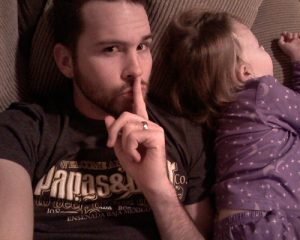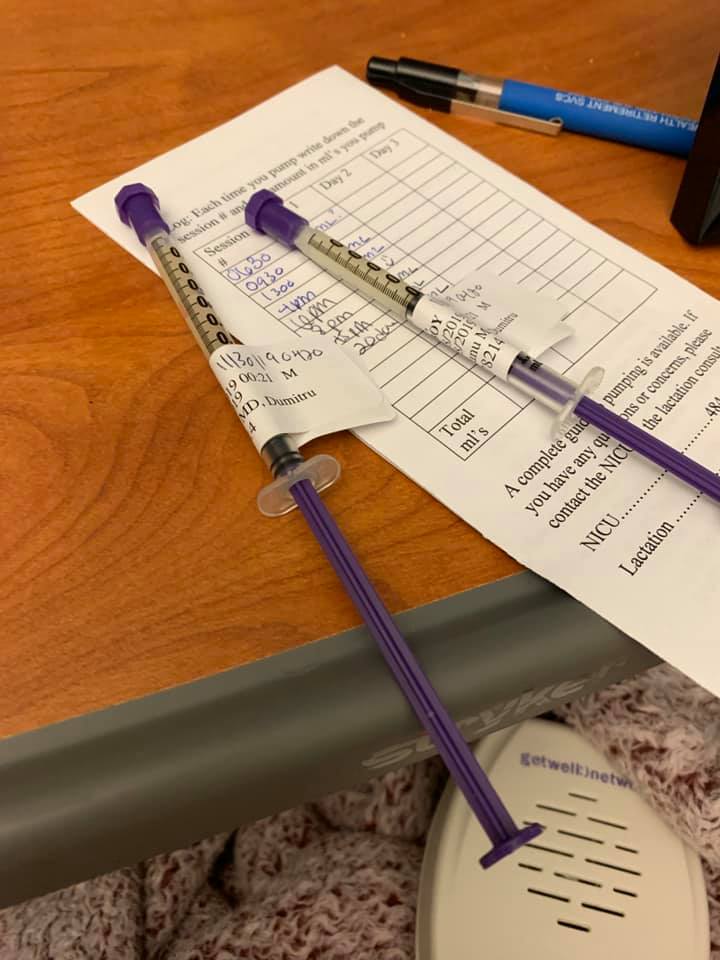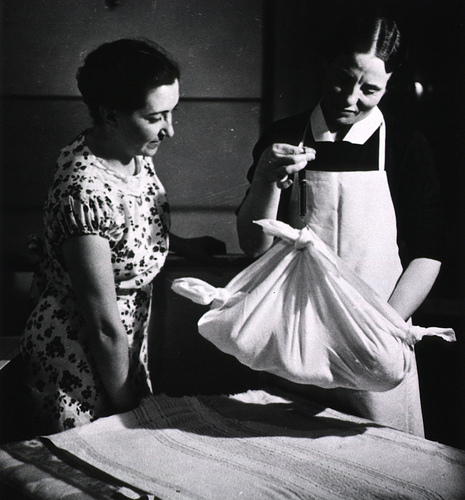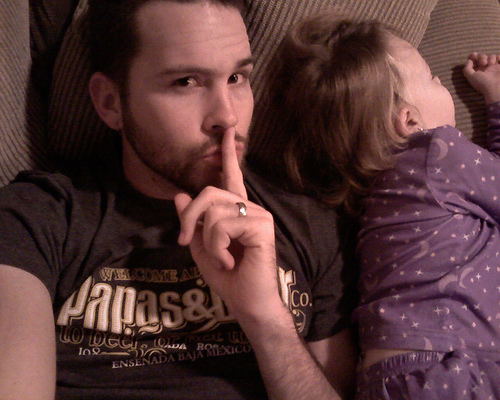By Michelle McKeown Poole, MS, RN, IBCLC.

Scene I
A bedroom. The clock on the nightstand reads 3:30 a.m. Mom is awake and nervously looking at the clock. A second figure snores under the covers.
Mom: Honey. Psst. HONEY.
Partner: Hmmmpf?
Mom: The baby’s been sleeping for three hours and seventeen minutes.
Partner: So?
Mom: So – we were told to feed him every two to three hours. Do you think we should wake him?
Partner: Are you crazy, it took forever to get him to sleep!
Mom: Ok, so let’s say that we don’t wake him. What time will the next feed start then? Do I wake him up in an hour? Or two hours? But if I wait two hours, it will be, let’s see…FIVE hours since he last ate!
Partner: So?
Mom: So I think that’s too long, right?
Partner: I dunno. Won’t he wake up if he’s hungry?
Mom: I don’t know! What if he doesn’t wake up – should I pump?
Partner: What? Why would you pump?
Mom: Because I don’t want my milk to dry up!
Partner: I dunno, I guess?
Mom: You guess what?!?
Partner: Pump?
Mom: Ok and then after I pump, do I wait another two hours before trying to feed again? What if the baby wakes up right after I pump?? There will be no milk left! He’ll be so hungry! What do I do then??
Partner: Ummm…
Baby starts crying and the parents look at each other, clearly relieved.
End scene.

Sound familiar?
This question of waking or not waking can really get under your new parenting skin. Your gut is telling you that a sleeping baby is a beautiful thing and why on earth would you disturb that? But the nervous mommy part of you is freaking out looking at the clock and you imagine your milk supply dropping with every tick of the second hand.
Like many things parenting, there is no one right or wrong answer here. (Sorry.) You should decide on a plan, try it out, and if it works for you, use it!
In this case, a winning plan will be one in which your baby is gaining well AND you are ALL sleeping well.
And I think I have a winner.
Are you ready to give it a try?
(Thought so.)
I am going to assume that breastfeeding is going well for you, and that we’re talking about a healthy full term baby. (If these conditions don’t apply, consider seeing a lactation consultant to come up with a plan that is more suited to your specific needs.)
This plan involves waking the baby during the day, and letting him sleep at night.
Here’s what you’ll do:
You’re going to replace the “feed your baby every 2-3 hours” rule with the new and improved “feed your baby at least 8 times in 24 hours” rule. Eight good feedings (15-45 minutes of active sucking and swallows) is the minimum amount most newborns need in order to gain well. Most newborns will eat more often than that (8-12 times is normal), but 8 is the minimum.
During the day, I want you to wake the baby for feeds, if he is not asking to be fed at least every 2-3 hours. When it comes to timing, I want you to watch the clock AND your baby. Babies have a 50-60 minute sleep cycle. This means that about once every hour, your baby is going to be in a very light sleep state. And a baby in a light sleep state is much easier to wake than a baby in a state of deep sleep.
Babies in a light sleep state will stir, you may see their eyelids flutter, or rapid eye movement as they dream. They may even make little mouth motions or suck in their sleep. When you see these signs anywhere around the 2-3 hour mark, pick your baby up, unwrap him, talk to him, change his diaper if need be and then invite him to eat. Hopefully, he will be awake enough to eat well. If you spend a good 5 minutes trying to wake him but he is not having it, stop. Wrap him up, put him back down and then try again over the next hour when you see those signs of light sleep.
So to review – while you are awake, you are feeding your baby every 2-3 hours.
At night, the plan will vary a bit based on how old your baby is.
If your baby is less than 2 weeks old: Your supply is still being established during this time, and your body is much more sensitive to the “make milk” or “don’t make milk” messages that it receives through breastfeeding (or not breastfeeding, respectively). After about 6 hours of no milk being removed, your body will start to down regulate. And in this period where you don’t have a full supply to begin with, down regulation is a bad thing. So when you are ready to go to bed, put your baby down, put yourself down, and set your alarm for a 5 hour stretch. If your baby hasn’t woken up by the point your alarm goes off, use the gentle waking techniques above to get a feeding in.
Once your baby has hit the 2 week mark: he should be back to birth weight, which is a solid confirmation that you are doing a great job with feeding. (Yay!) It also means that you can stop setting an alarm. (Yay!) At this point, if your baby wants to sleep longer than a 6 hour stretch (and if he has you’ve won the baby lottery), let him. (Yay!) As long as he is still getting those minimum 8 solid feedings in during the rest of the day, you are good to go with the “no wake” plan. If baby continues to sleep 6 hour + stretches on a regular basis, your milk supply will begin to downregulate during those stretches. But this is ok, because you are now working with a full milk supply. As your baby demands more milk during his waking hours, your supply will correspondingly increase at those times to meet his needs.
And don’t worry. Your breasts are never empty. So if your baby has second thoughts about his long sleeping stretches and starts to wake during shorter intervals overnight, there will be milk there for him. It may take him a little longer to fill up, but he will. And if he continues waking and eating at shorter intervals overnight, in a few days your breasts will be full again when he is ready to eat.
And then he’ll start sleeping through again to make you crazy. Because that’s what babies do.
So there it is, a win-win plan for success! Give it a try over a few days/nights and see how it’s working for you. If you are getting some more sleep, and baby is getting enough to eat, it’s a keeper!

P.S. – This plan can be a great solution for bottle feeding moms, too!
photo credits: Daily Self Portrait December 30, 2007 via photopin (license) , Crying via photopin (license) , owen via photopin (license)

















